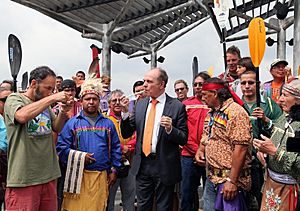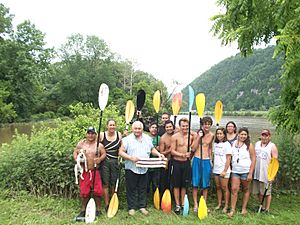Two Row Wampum Treaty facts for kids

The Two Row Wampum Treaty, also known as Guswenta or Kaswentha, is a very old agreement. It was made in 1613 between the Haudenosaunee people and the Dutch government. This happened in what is now upstate New York.
The Haudenosaunee see this agreement as the foundation for all their later treaties. This includes agreements with the British and the United States. Indigenous peoples in these areas deeply respect the treaty. It is remembered through special wampum belts and oral stories passed down over generations.
However, some written versions of the agreement have caused debate. Some experts question if a treaty between the Dutch and the Mohawk people happened exactly as remembered, or if it was at a later time. In 2013, a history journal published many articles about the Two Row Tradition.
Contents
The Treaty's Beginnings
At the start of the 1600s, the Iroquois Mohawk and Mahican peoples lived near each other. This area is now called the mid-Hudson Valley. After Henry Hudson explored the Hudson River in 1609, traders from the Netherlands arrived. They set up trading posts to buy and sell furs, especially from beavers. These animals were plentiful in the region. By 1614, the Dutch built Fort Nassau. This was the start of their colony called New Netherland.
What Kaswentha Means
Kaswentha is a Haudenosaunee word. It describes how they wanted to live with European settlers. It means that two groups should live in peace without getting in each other's way. They should respect each other's freedom.
The Two Row Belt shows this idea. It is a long belt made of white wampum beads. It has two parallel lines of purple wampum beads. These lines stand for two separate boats or vessels. One boat is for the Haudenosaunee, and the other is for the Europeans. Both boats travel side-by-side down the river of life. Neither side should try to "steer" the other's boat. This means they should not try to control each other. The word for wampum belt, kahionni, means a river made by humans. It shows friendship and connects different people.
The Agreement Details
Haudenosaunee oral history says the kaswentha relationship began around 1613. It was an agreement between the Mohawks and a Dutch trader named Jacob Eelckens. This happened at a place called Tawagonshi. This was before the Dutch built Fort Nassau.
Haudenosaunee leaders have spoken about this agreement for centuries. In 1701, they said it happened "above eighty years" before. In 1744, a leader named Canasatego said it was "above One Hundred Years Ago." This supports the idea that the agreement is very old.
Oral History Versus Written Records
Historians have looked at old written records to see if they match the Haudenosaunee oral stories. They found that the Haudenosaunee have always spoken about the main ideas of kaswentha in a very consistent way. The earliest written record that supports the 1613 agreement is from 1689. However, Haudenosaunee people spoke about kaswentha even earlier, in 1656.
While it seems clear that the Haudenosaunee and Dutch made some kind of agreement, some historians are careful. They wonder if the Dutch saw it as a formal "treaty" in the same way the Haudenosaunee did. For example, before 1621, Dutch traders usually did not make formal treaties with Native peoples unless there were specific threats or strong Indigenous governments. These conditions were not present in North America at that exact time.
Historians like Jaap Jacobs say that Dutch traders probably made agreements with local Native groups. This would explain why the Dutch built Fort Nassau on Native lands. But these agreements might not have been formal treaties between nations, at least not in European terms. So, while 2013 was celebrated as the 400th anniversary, some historians say a formal treaty might have happened a bit later, after 1621.
The Haudenosaunee Perspective
Even with these debates, Haudenosaunee tradition clearly remembers the treaty and its meaning. When the Dutch suggested they be like "Father and Son," the Haudenosaunee replied: "We will not be like Father and Son, but like Brothers." "Neither of us will make laws for the other or get involved in the other's business." "Neither of us will try to steer the other's vessel."
Haudenosaunee people believe this treaty is still in effect today. Their tradition says: "As long as the Sun shines upon this Earth, that is how long our Agreement will stand." "Second, as long as the Water still flows." "And Third, as long as the Grass Grows Green at a certain time of the year." "Now we have Symbolized this Agreement and it shall be binding forever as long as Mother Earth is still in motion."
The Wampum Belts
Wampum belts, like the Two Row style, are a way to show important agreements. They are physical symbols of the kaswentha relationship.
Haudenosaunee people used wampum for diplomacy even before Europeans arrived. After contact, wampum became even more important for communicating between cultures. Historians discuss if the special two-row style wampum belts could have been made as early as 1613. However, archaeological findings do not rule out this possibility.
Symbolism of the Two Row Wampum
The two-row wampum belt shows the "ship and canoe" idea of kaswentha. This is one of the most important ways the Haudenosaunee have shown their relationship with newcomers. The belt has two rows of purple wampum beads on a white background. Each row is like a parallel river. The vessels of each people travel down their own river, independently. But they also support each other.
It is not certain what materials were exchanged when the treaty was first made. While a two-row wampum belt might have been part of the first talks, there is no written proof. However, Haudenosaunee oral tradition says wampum belts were used in later ceremonies to renew the agreement.
Many early stories about kaswentha do not specifically mention wampum belts. But descriptions of wampum belts from that time are often not very detailed. Also, wampum belts were fragile and could easily break apart. So, it is not surprising that very old belts might not have survived.
By 1870, the image of the two-row wampum belt had become a strong symbol. It showed the Haudenosaunee's ongoing treaty with the Dutch and later the British. The idea of a "chain" connecting the two peoples also continued. This chain was first described as iron, then silver. It showed the friendship that allowed the "ship and canoe" relationship to exist. The two ideas worked together.
Some people, like Diana Muir Appelbaum, have said there is no proof an "original" two-row wampum belt ever existed. They also question the 1613 treaty itself, linking it to a document that might have been faked in the 1960s. It is true that no physical evidence from the 1613 negotiations survives.
However, experts like Jon Parmenter explain that the strength of the kaswentha tradition does not depend on one single document. Haudenosaunee and Europeans spoke about these ideas long before the late 1800s. The kaswentha relationship changed over time as ties grew stronger. But it definitely existed. It is important to look at all the evidence, not just one document, when studying Indigenous oral traditions.
Oral Tradition's Importance
Leaders of the Onondaga Nation say that their oral tradition, which goes along with the wampum belts, proves that an agreement was made in 1613. Andy Mager of the Syracuse Peace Council said, "We believe the Haudenosaunee oral history of the treaty... We believe the basic outlines of a treaty and that a treaty was negotiated between representatives of the Dutch and the Haudenosaunee in or around 1613."
The Tawagonshi Document Debate
A written version of the treaty was first shown to the public in 1968. This was by a collector named L.G. van Loon. He said he got it from someone on the Mississaugua reserve in Canada.
In 1987, some experts said this written version was a fake. They found grammar mistakes that would not have been made in the 1600s. They also saw handwriting styles from both the 17th and 20th centuries. The document used village names instead of chiefs' names. They also said the writing was "too smooth" for a 17th-century quill pen. Since Van Loon had faked other old documents, they thought he was the most likely person to have faked this one. In 2013, more language experts also found many grammar mistakes. They said it was impossible for the text to be from 1613.
However, some people, like retired Cornell University professor Robert Venables, believe the document is real. They say that any problems with the language or handwriting could be because it was copied by hand years after 1613.
The document was given to the Onondagas and is kept near Syracuse, New York.
400th Anniversary Celebration
In 2013, hundreds of Native Americans and their supporters took part in a special river journey. They wanted to honor and renew the Two Row Wampum Treaty. People canoed and kayaked across New York State. They wanted to bring attention to the treaty and its importance for Native land rights and protecting the environment.
The paddlers traveled over 300 miles. They went from Onondaga, where the Haudenosaunee league began, along the Mohawk and Hudson rivers to New York City. The journey ended with a special meeting at the United Nations. This anniversary journey helped the Two Row Treaty get attention from around the world.
The Onondaga Nation and Neighbors of the Onondaga Nation (NOON) organized the journey. Public events were held in places like Kanatsiohareke Mohawk Community, Albany, and Poughkeepsie. Native leaders and government officials talked about the treaty and how it relates to today's issues. On August 9, the paddlers arrived in New York City. They attended a UN session for Indigenous Peoples Day. The UN Secretary General, Ban Ki-moon, and country representatives were there. UN officials stressed the UN's role in making peace and protecting treaty rights. Oren Lyons, a diplomat from the Onondaga Turtle Clan, said the Two Row Treaty was the basis for all Haudenosaunee treaties. He noted that many of these treaties have since been broken by New York State, the US, and Canada. UN representatives from Panama and Bolivia shared how they work to return land to Native ownership and protection. The UN Secretary for Human Rights said the UN wants to fix treaty violations. They see them as human rights violations and want to help enforce treaties like the Two Row in the future.




